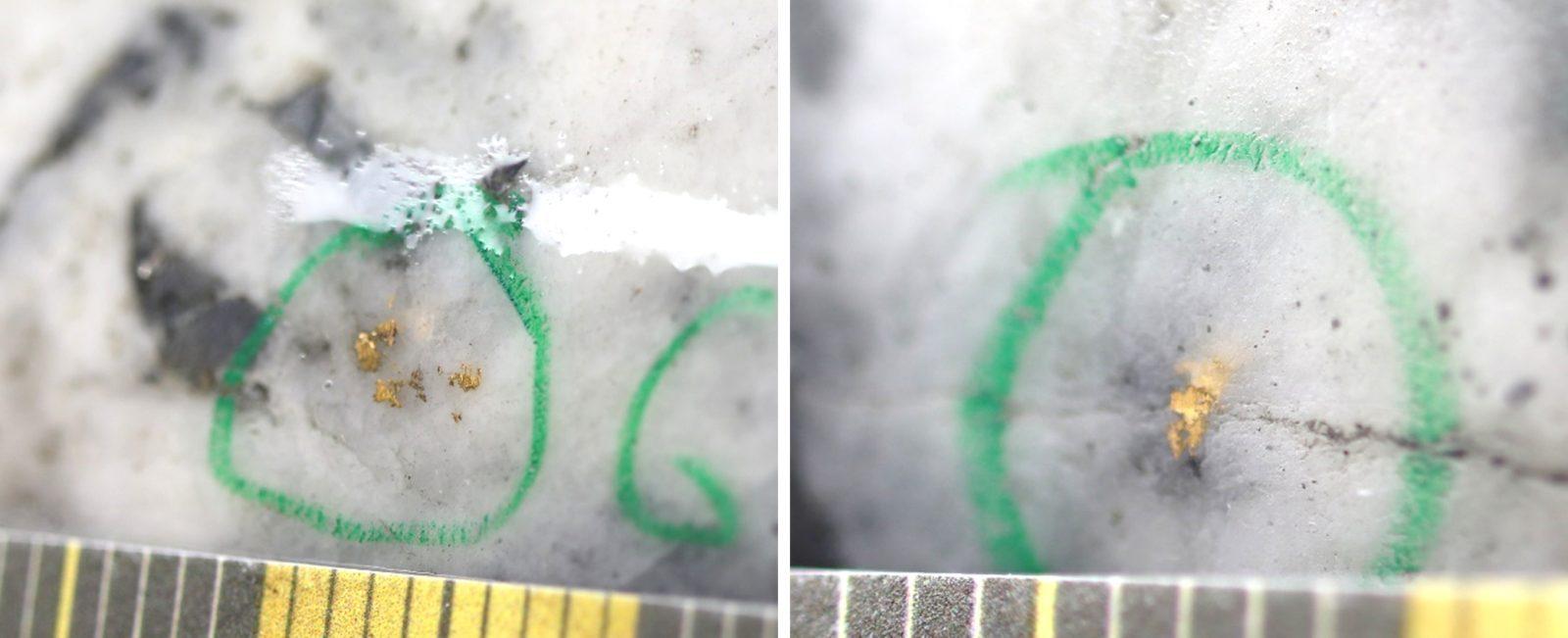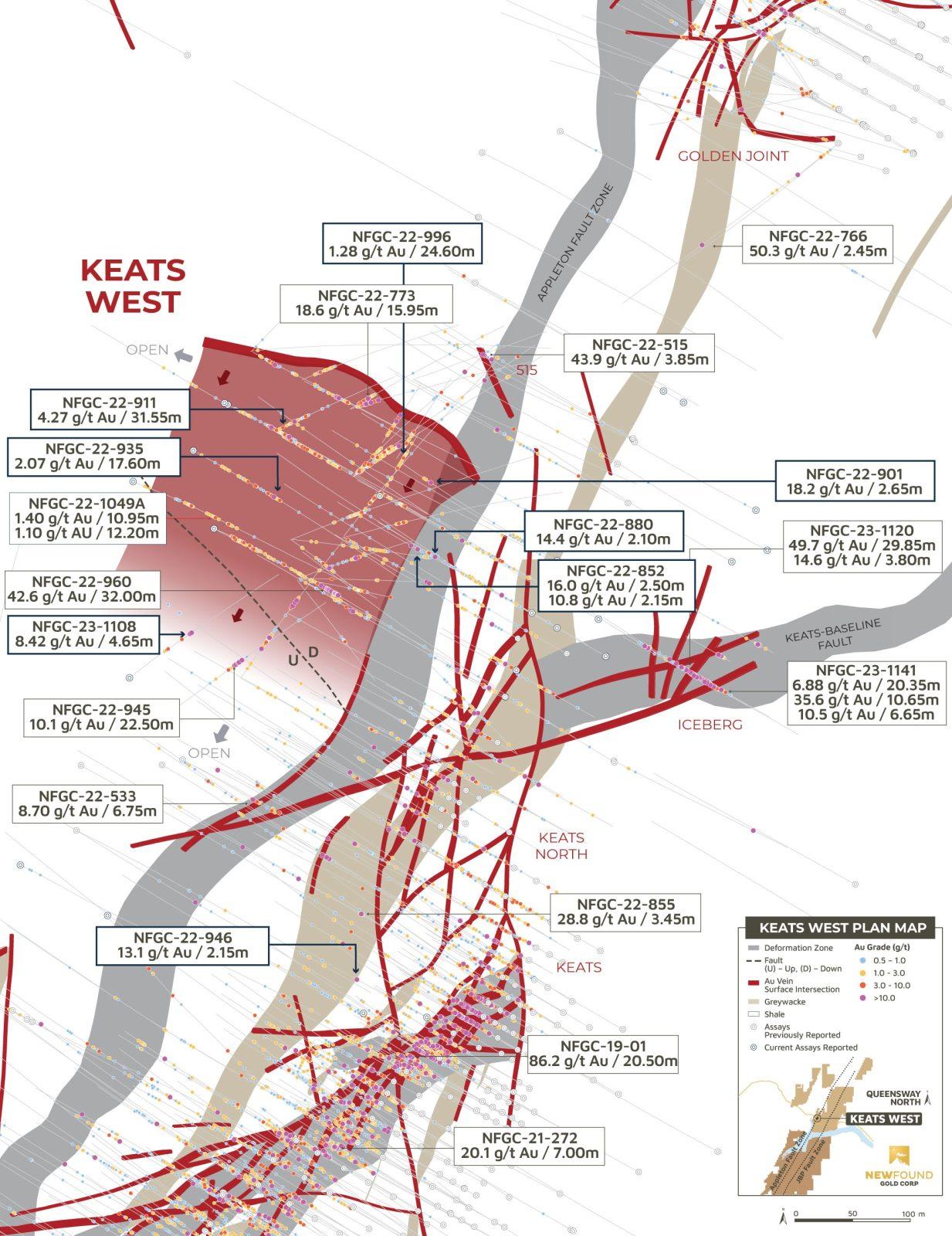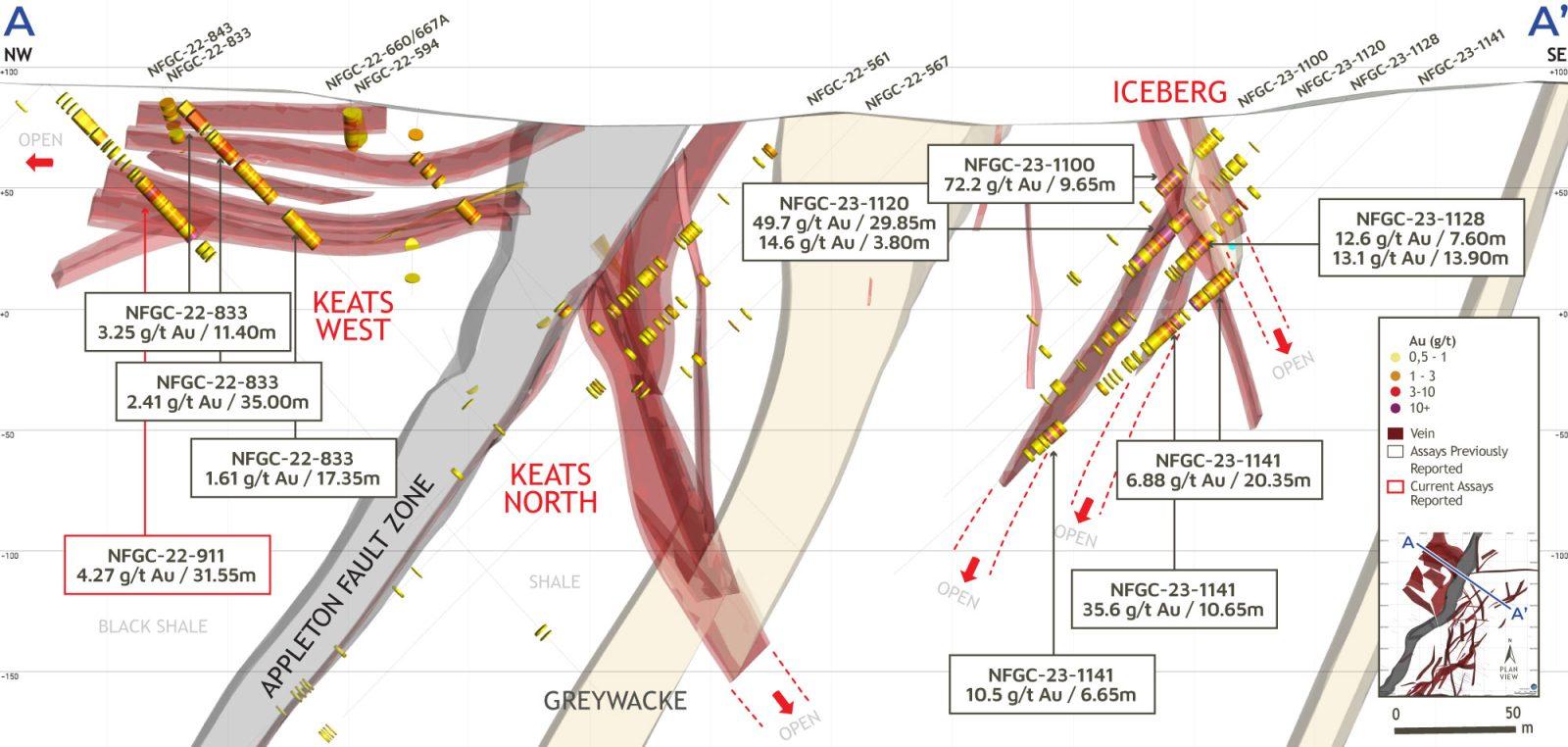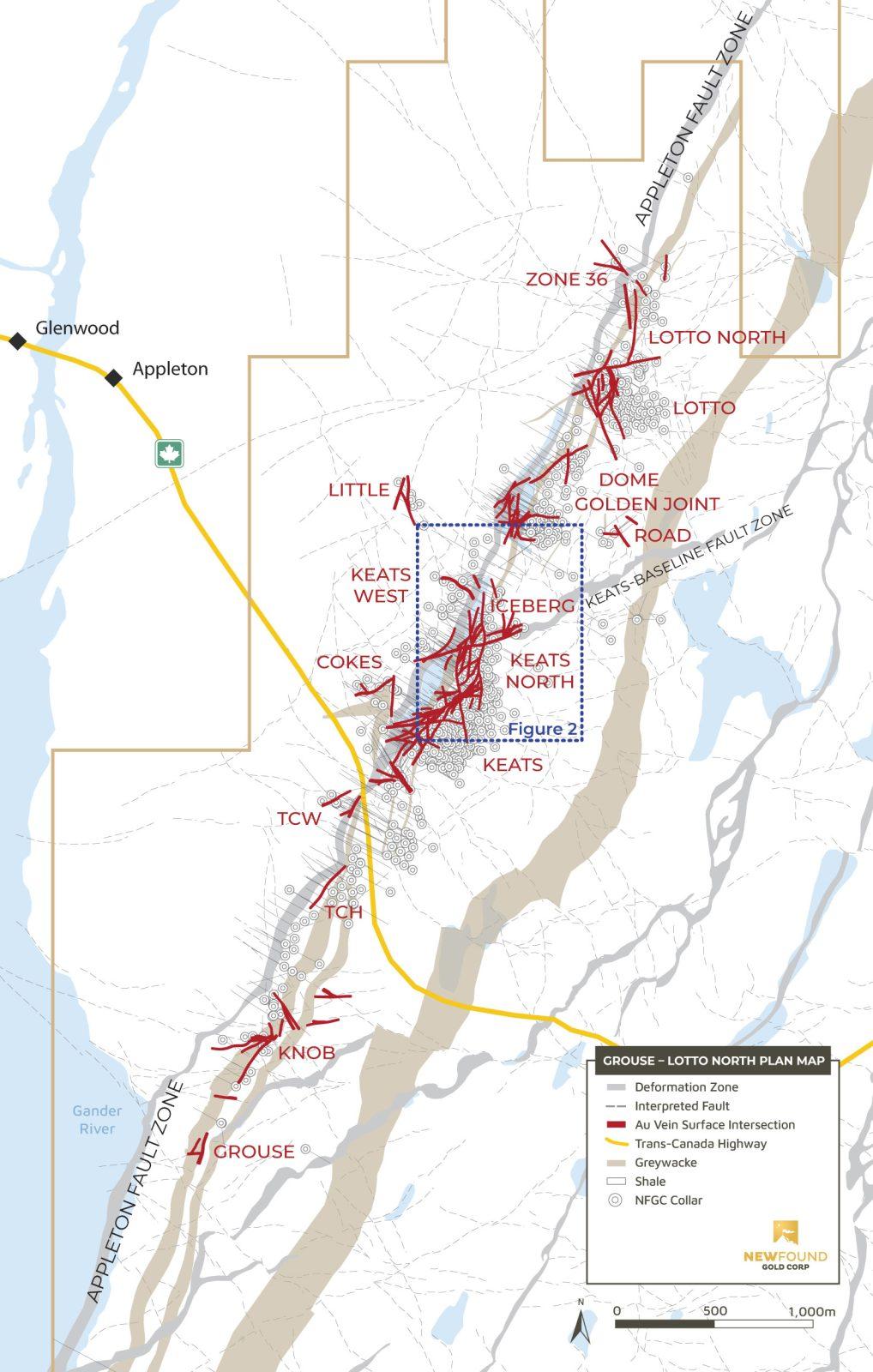
New Found Intercepts 4.27 g/t Au Over 31.55m, Extends Keats West to 250m Along Strike

New Found Gold Corp. (TSX-V: NFG) (NYSE-A: NFGC) is pleased to announce the results from 25 diamond drill holes that were completed as part of a drill program designed to expand on both the newly discovered Keats West zone, a low-angle thrust fault that dips gently to the south-southwest and located on the west side of the highly prospective Appleton Fault Zone and from Keats North. New Found’s 100%-owned Queensway project comprises a 1,662km2 area, accessible via the Trans-Canada Highway, 15km west of Gander, Newfoundland and Labrador.
Keats West and Keats North Highlights:
| Hole No. | From (m) | To (m) | Interval (m)1 | Au (g/t) | Zone | |
| NFGC-22-852 | 161.95 | 164.45 | 2.50 | 16.00 | Keats N | |
| Including | 162.90 | 163.45 | 0.55 | 69.10 | ||
| And | 171.50 | 173.65 | 2.15 | 10.76 | ||
| Including | 172.50 | 173.05 | 0.55 | 40.50 | ||
| NFGC-22-880 | 173.75 | 175.85 | 2.10 | 14.43 | Keats N | |
| Including | 174.50 | 174.95 | 0.45 | 64.00 | ||
| NFGC-22-901 | 181.65 | 184.30 | 2.65 | 18.17 | Keats N | |
| Including | 182.80 | 183.20 | 0.40 | 98.70 | ||
| NFGC-22-946 | 94.85 | 97.00 | 2.15 | 13.12 | Keats FW | |
| Including | 95.40 | 96.40 | 1.00 | 27.80 | ||
| NFGC-22-911 | 56.00 | 87.55 | 31.55 | 4.27 | Keats W | |
| Including | 60.70 | 62.10 | 1.40 | 14.66 | ||
| Including | 86.00 | 87.55 | 1.55 | 31.06 | ||
| NFGC-22-935 | 105.90 | 123.50 | 17.60 | 2.07 | Keats W | |
| Including | 114.45 | 114.85 | 0.40 | 10.60 | ||
| NFGC-22-996 | 39.40 | 64.00 | 24.60 | 1.28 | Keats W | |
| NFGC-22-1049A | 66.40 | 77.35 | 10.95 | 1.40 | Keats W | |
| And | 95.00 | 107.20 | 12.20 | 1.10 | ||
| NFGC-23-1108 | 94.00 | 98.65 | 4.65 | 8.42 | Keats W | |
| Including | 95.00 | 96.45 | 1.45 | 12.47 | ||
| Including | 98.00 | 98.65 | 0.65 | 12.60 |
Table 1: Keats West and Keats North Drilling Highlights
1Note at Keats West, host structures are interpreted to be shallowly dipping and true widths are generally estimated to be 60% to 95% of reported intervals. At Keats North, true widths are unknown at this time. At Keats FW host structures are interpreted to be steeply dipping and true widths are generally estimated to be 40% to 55% of reported intervals. Infill veining in secondary structures with multiple orientations crosscutting the primary host structures are commonly observed in drill core which could result in additional uncertainty in true width. Composite intervals reported carry a minimum weighted average of 1 g/t Au diluted over a minimum core length of 2m with a maximum of 4m consecutive dilution. Included high-grade intercepts are reported as any consecutive interval with grades greater than 10 g/t Au. Grades have not been capped in the averaging and intervals are reported as drill thickness.
- Step-out drilling has increased the strike length at Keats West to 250m. The mineralized footprint of Keats West now spans 250m wide x 305m down dip, averaging approximately 30m thick.
- Infill drilling at Keats West continues to demonstrate excellent continuity of the gold mineralization over broad thicknesses with highlight intervals of 4.27 g/t Au over 31.55m in NFGC-22-911, 8.42 g/t Au over 4.65m in NFGC-23-1108 and 2.07 g/t Au over 17.60m in NFGC-22-935 (Figures 1 – 3).
- At Keats North, drilling continues to intercept high-grade gold mineralization throughout this extensive network of veins and structure with highlight results of 16.0 g/t Au over 2.50m and 10.8 g/t Au over 2.15m in NFGC-22-852, 18.2 g/t Au over 2.65m in NFGC-22-901 and 14.4 g/t Au over 2.10m in NFGC-22-880. As shown in Figure 3, Keats North is located between Keats West and Iceberg adjacent to the AFZ; this domain is considered prime territory for making additional high-grade gold discoveries.
Melissa Render, VP of Exploration for New Found, stated: “Keats West ranks high amongst the many discoveries made to date at Queensway. It is also a very unique zone and for many reasons:
- Keats West represents the first major discovery made on the west side of the AFZ.
- It is the only structure discovered to date with a flat-lying orientation.
- The consistency of mineralization contained within the host structure is comparable to that of Keats and Iceberg, and in many cases is more uniformly and broadly distributed.
- The low-angle orientation has allowed drilling to remain shallow, still largely focused within the top 100m.
“Yet, despite its uniqueness, Keats West has also delivered two intercepts that reside on our list of top intervals ever drilled on the property including 42.6 g/t Au over 32.00m in NFGC-22-960 (released November 28, 2022) and 18.6 g/t Au over 16.00m in NFGC-22-773 (released on November 23, 2022). This reinforces that high-grade gold at Queensway can be found in a variety of structures and geological environments leading to no shortage of gold targets.”
Drillhole Details
| Hole No. | From (m) | To (m) | Interval (m)1 | Au (g/t) | Zone | |
| NFGC-22-806 | 47.00 | 49.00 | 2.00 | 3.67 | Keats N | |
| NFGC-22-813 | 10.30 | 13.00 | 2.70 | 1.97 | Keats N | |
| And2 | 22.00 | 36.10 | 14.10 | 2.13 | ||
| Including2 | 22.55 | 23.60 | 1.05 | 15.67 | ||
| And | 47.50 | 49.70 | 2.20 | 1.01 | ||
| NFGC-22-839 | 168.80 | 171.20 | 2.40 | 1.02 | Keats N | |
| And | 257.00 | 259.40 | 2.40 | 1.65 | ||
| NFGC-22-852 | 96.70 | 98.90 | 2.20 | 1.49 | Keats N | |
| And | 161.95 | 164.45 | 2.50 | 16.00 | ||
| Including | 162.90 | 163.45 | 0.55 | 69.10 | ||
| And | 171.50 | 173.65 | 2.15 | 10.76 | ||
| Including | 172.50 | 173.05 | 0.55 | 40.50 | ||
| And | 245.00 | 247.00 | 2.00 | 1.51 | ||
| NFGC-22-860 | 191.80 | 194.00 | 2.20 | 1.09 | Keats FW | |
| And | 216.00 | 218.00 | 2.00 | 7.94 | ||
| Including | 216.60 | 217.30 | 0.70 | 22.20 | ||
| And | 363.30 | 367.15 | 3.85 | 3.23 | ||
| NFGC-22-864 | 139.50 | 141.65 | 2.15 | 1.21 | Keats N | |
| NFGC-22-880 | 113.65 | 116.15 | 2.50 | 1.01 | Keats N | |
| And | 173.75 | 175.85 | 2.10 | 14.43 | ||
| Including | 174.50 | 174.95 | 0.45 | 64.00 | ||
| NFGC-22-901 | 52.70 | 54.85 | 2.15 | 1.16 | Keats N | |
| And | 62.00 | 64.25 | 2.25 | 1.07 | ||
| And | 181.65 | 184.30 | 2.65 | 18.17 | ||
| Including | 182.80 | 183.20 | 0.40 | 98.70 | ||
| NFGC-22-907 | 90.00 | 92.15 | 2.15 | 1.97 | Keats FW | |
| And | 99.00 | 101.00 | 2.00 | 1.19 | ||
| And | 139.60 | 142.00 | 2.40 | 1.17 | ||
| And | 247.15 | 249.90 | 2.75 | 1.67 | ||
| NFGC-22-909 | No Significant Values | Keats N | ||||
| NFGC-22-911 | 16.80 | 24.20 | 7.40 | 1.33 | Keats W | |
| And | 29.00 | 32.05 | 3.05 | 1.41 | ||
| And | 56.00 | 87.55 | 31.55 | 4.27 | ||
| Including | 60.70 | 62.10 | 1.40 | 14.66 | ||
| Including | 86.00 | 87.55 | 1.55 | 31.06 | ||
| NFGC-22-921 | No Significant Values | Keats N | ||||
| NFGC-22-926 | No Significant Values | Keats W | ||||
| NFGC-22-935 | 11.00 | 13.00 | 2.00 | 1.14 | Keats W | |
| And | 39.60 | 46.00 | 6.40 | 1.36 | ||
| And | 63.00 | 65.00 | 2.00 | 1.30 | ||
| And | 70.60 | 78.00 | 7.40 | 2.11 | ||
| And | 86.00 | 90.00 | 4.00 | 2.68 | ||
| And | 105.90 | 123.50 | 17.60 | 2.07 | ||
| Including | 114.45 | 114.85 | 0.40 | 10.60 | ||
| NFGC-22-936 | 253.85 | 255.85 | 2.00 | 1.59 | Keats N | |
| And | 315.00 | 317.00 | 2.00 | 1.85 | ||
| NFGC-22-946 | 94.85 | 97.00 | 2.15 | 13.12 | Keats FW | |
| Including | 95.40 | 96.40 | 1.00 | 27.80 | ||
| NFGC-22-961 | 75.90 | 78.15 | 2.25 | 1.57 | Keats N | |
| NFGC-22-967 | No Significant Values | Keats FW | ||||
| NFGC-22-978A | 24.85 | 32.35 | 7.50 | 2.32 | Keats W | |
| And | 37.10 | 44.75 | 7.65 | 2.33 | ||
| And | 51.40 | 54.40 | 3.00 | 3.97 | ||
| And | 102.55 | 105.20 | 2.65 | 3.36 | ||
| And | 126.00 | 136.70 | 10.70 | 1.34 | ||
| And | 145.10 | 148.65 | 3.55 | 1.05 | ||
| NFGC-22-996 | 23.40 | 25.75 | 2.35 | 2.54 | Keats W | |
| And | 39.40 | 64.00 | 24.60 | 1.28 | ||
| NFGC-22-1023 | No Significant Values | Keats N | ||||
| NFGC-22-1036 | No Significant Values | Keats N | ||||
| NFGC-22-1048 | No Significant Values | Keats N | ||||
| NFGC-22-1049A | 66.40 | 77.35 | 10.95 | 1.40 | Keats W | |
| And | 95.00 | 107.20 | 12.20 | 1.10 | ||
| And | 123.00 | 129.05 | 6.05 | 1.40 | ||
| NFGC-23-1108 | 56.00 | 62.30 | 6.30 | 2.39 | Keats W | |
| And | 82.40 | 84.70 | 2.30 | 1.28 | ||
| And | 94.00 | 98.65 | 4.65 | 8.42 | ||
| Including | 95.00 | 96.45 | 1.45 | 12.47 | ||
| Including | 98.00 | 98.65 | 0.65 | 12.60 | ||
Table 2: Summary of composite results reported in this press release for Keats West and Keats North
1Note at Keats West, host structures are interpreted to be shallowly dipping and true widths are generally estimated to be 60% to 95% of reported intervals. At Keats North, true widths are unknown at this time. At Keats FW host structures are interpreted to be steeply dipping and true widths are generally estimated to be 40% to 55% of reported intervals. Infill veining in secondary structures with multiple orientations crosscutting the primary host structures are commonly observed in drill core which could result in additional uncertainty in true width. Composite intervals reported carry a minimum weighted average of 1 g/t Au diluted over a minimum core length of 2m with a maximum of 4m consecutive dilution. Included high-grade intercepts are reported as any consecutive interval with grades greater than 10 g/t Au. Grades have not been capped in the averaging and intervals are reported as drill thickness.2Previously reported interval.
| Hole No. | Azimuth (°) | Dip (°) | Length (m) | UTM E | UTM N | Prospect | |||
| NFGC-22-806 | 300 | -62 | 188 | 658233 | 5427802 | Keats N | |||
| NFGC-22-813 | 300 | -62 | 158 | 658243 | 5427825 | Keats N | |||
| NFGC-22-839 | 299 | -45 | 332 | 658320 | 5427837 | Keats N | |||
| NFGC-22-852 | 300 | -45 | 281 | 658256 | 5427875 | Keats N | |||
| NFGC-22-860 | 119 | -45 | 414 | 657811 | 5427655 | Keats W | |||
| NFGC-22-864 | 300 | -45 | 503 | 658314 | 5427869 | Keats N | |||
| NFGC-22-880 | 300 | -45 | 416 | 658278 | 5427862 | Keats N | |||
| NFGC-22-901 | 300 | -45 | 227 | 658278 | 5427920 | Keats | |||
| NFGC-22-907 | 145 | -49 | 318 | 657887 | 5427611 | Keats W | |||
| NFGC-22-909 | 300 | -45 | 356 | 658297 | 5427909 | Keats N | |||
| NFGC-22-911 | 120 | -45 | 352 | 657991 | 5428056 | Keats W | |||
| NFGC-22-921 | 300 | -45 | 335 | 658321 | 5427895 | Keats N | |||
| NFGC-22-926 | 300 | -45 | 191 | 657989 | 5428057 | Keats W | |||
| NFGC-22-935 | 120 | -45 | 302 | 657962 | 5428016 | Keats W | |||
| NFGC-22-936 | 300 | -45 | 428 | 658388 | 5428058 | Keats | |||
| NFGC-22-946 | 300 | -45 | 176 | 658165 | 5427523 | Keats | |||
| NFGC-22-961 | 300 | -45 | 302 | 658370 | 5428068 | Keats | |||
| NFGC-22-967 | 300 | -45 | 329 | 658109 | 5427526 | Keats | |||
| NFGC-22-978A | 118 | -50 | 204 | 657980 | 5427948 | Keats W | |||
| NFGC-22-996 | 35 | -45 | 93 | 658124 | 5427976 | Keats W | |||
| NFGC-22-1023 | 300 | -45 | 167 | 658451 | 5427964 | Keats N | |||
| NFGC-22-1036 | 300 | -45 | 257 | 658461 | 5427929 | Keats N | |||
| NFGC-22-1048 | 300 | -45 | 275 | 658430 | 5427919 | Keats N | |||
| NFGC-22-1049A | 114 | -45 | 315 | 657909 | 5427989 | Keats W | |||
| NFGC-23-1108 | 55 | -47 | 233 | 657906 | 5427818 | Keats W |
Table 3: Details of drill holes reported in this press release
Queensway 500,000m Drill Program Update
The Company is currently undertaking a 500,000m drill program at Queensway and approximately 60,600m of core is currently pending assay results.
Sampling, Sub-sampling, and Laboratory
Assays are uncut, and composite intervals are calculated using a minimum weighted average of 1 g/t Au diluted over a minimum core length of 2m with a maximum of 4m consecutive dilution. Included high-grade intercepts are reported as any consecutive interval with grades greater than 10 g/t Au.
All drilling recovers HQ core. Drill core is split in half using a diamond saw or a hydraulic splitter for rare intersections with incompetent core.
A geologist examines the drill core and marks out the intervals to be sampled and the cutting line. Sample lengths are mostly 1.0 meter and adjusted to respect lithological and/or mineralogical contacts and isolate narrow (<1.0m) veins or other structures that may yield higher grades.
Technicians saw the core along the defined cutting line. One-half of the core is kept as a witness sample and the other half is submitted for analysis. Individual sample bags are sealed and placed into totes, which are then sealed and marked with the contents.
New Found submits samples for gold determination by fire assay to ALS Canada Ltd. (“ALS”) and by photon assay to MSALABS (“MSA”) since June 2022. ALS and MSA operate under a commercial contract with New Found.
Drill core samples are shipped to ALS for sample preparation in Sudbury, Ontario, Thunder Bay, Ontario, or Moncton, New Brunswick. ALS is an ISO-17025 accredited laboratory for the fire assay method.
Drill core samples are also submitted to MSA in Val-d’Or, Quebec. MSA operates numerous laboratories worldwide and maintains ISO-17025 accreditation for many metal determination methods. Accreditation of the photon assay method at the MSA Val D’Or laboratory is in progress.
At ALS, the entire sample is crushed to approximately 70% passing 2mm. A 3,000-g split is pulverized. “Routine” samples do not have visible gold (VG) identified and are not within a mineralized zone. Routine samples are assayed for gold by 30-g fire assay with an inductively-couple plasma spectrometry (ICP) finish. If the initial 30-g fire assay gold result is over 1 g/t, the remainder of the 3,000-g split is screened at 106 microns for screened metallics assay. For the screened metallics assay, the entire coarse fraction (sized greater than 106 microns) is fire assayed and two splits of the fine fraction (sized less than 106 microns) are fire assayed. The three assays are combined on a weight-averaged basis. Samples that have VG identified or fall within a mineralized interval are automatically submitted for screened metallic assay for gold.
At MSA, the entire sample is crushed to approximately 70% passing 2mm. For “routine” samples that do not have VG identified and are not within a mineralized zone, the samples are riffle split to fill two 450g jars for photon assay. The assays reported from both jars are combined on a weight-averaged basis. If one of the jars assays greater than 1 g/t, the remaining crushed material is weighed into multiple jars and are submitted for photon assay.
For samples that have VG identified or are within a mineralized zone, the entire crushed sample is weighed into multiple jars and are submitted for photon assay. The assays from all jars are combined on a weight-averaged basis.
All samples prepared at ALS or MSA are also analyzed for a multi-element ICP package (ALS method code ME-ICP61) at ALS Vancouver.
Drill program design, Quality Assurance/Quality Control and interpretation of results are performed by qualified persons employing a rigorous Quality Assurance/Quality Control program consistent with industry best practices. Standards and blanks account for a minimum of 10% of the samples in addition to the laboratory’s internal quality assurance programs.
Quality Control data are evaluated on receipt from the laboratories for failures. Appropriate action is taken if assay results for standards and blanks fall outside allowed tolerances. All results stated have passed New Found’s quality control protocols.
New Found’s quality control program also includes submission of the second half of the core for approximately 5% of the drilled intervals. In addition, approximately 1% of sample pulps for mineralized samples are submitted for re-analysis to a second ISO-accredited laboratory for check assays.
The Company does not recognize any factors of drilling, sampling or recovery that could materially affect the accuracy or reliability of the assay data disclosed.
The assay data disclosed in this news release have been verified by the Company’s Qualified Person against the original assay certificates.
The Company notes that it has not completed any economic evaluations of its Queensway Project and that the Queensway Project does not have any resources or reserves.
Qualified Person
The scientific and technical information disclosed in this press release was reviewed and approved by Greg Matheson, P. Geo., Chief Operating Officer, and a Qualified Person as defined under National Instrument 43-101. Mr. Matheson consents to the publication of this press release dated April 18, 2023, by New Found. Mr. Matheson certifies that this press release fairly and accurately represents the scientific and technical information that forms the basis for this press release.
About New Found Gold Corp.
New Found holds a 100% interest in the Queensway Project, located 15km west of Gander, Newfoundland and Labrador, and just 18km from Gander International Airport. The project is intersected by the Trans-Canada Highway and has logging roads crosscutting the project, high voltage electric power lines running through the project area, and easy access to a highly skilled workforce. The Company is currently undertaking a 500,000m drill program at Queensway and is well funded for this program with cash and marketable securities of approximately $64 million as of April 2023.

Figure 1: Photos of mineralization from NFGC-22-911: Left: at ~60.4m Right: at ~62m. ^Note that these photos are not intended to be representative of gold mineralization in NFGC-22-911. (Photo: Business Wire)

Figure 2. Keats West plan view map (Photo: Business Wire)

Figure 3. Keats West to Iceberg cross-section view (+/- 12.5m, looking northwest) (Photo: Business Wire)

Figure 4. Grouse – Lotto North plan view map (Photo: Business Wire)
MORE or "UNCATEGORIZED"
Visionary Copper and Gold Mines Inc. Closes First Tranche of Private Placement Financing
Visionary Copper and Gold Mines Inc. (TSX-V: VCG) (OTCQX: VCGMF) ... READ MORE
Globex Reports First Drill Results from Rouyn-Merger
GLOBEX MINING ENTERPRISES INC. (TSX:GMX) (FRA:G1MN) (OTCQX:GLBX... READ MORE
Revival Gold Provides Update and Latest Results From Drilling at the Mercur Gold Project in Utah
Revival Gold Inc. (TSX-V: RVG) (OTCQX: RVLGF) is pleased to prov... READ MORE
Eloro Resources Intersects Highest Silver Interval to Date at its Iska Iska project, Southern Bolivia with 72 metres grading 294.81 g/t Silver within a broader interval of 180 metres grading 164.74 g/t Silver in Hole DSB-93
Highlights: Eloro’s second phase definition diamond drillin... READ MORE
Aya Gold & Silver Reports High-Grade Silver Results at Zgounder
Aya Gold & Silver Inc. (TSX: AYA; OTCQX: AYASF) is pleased to... READ MORE












